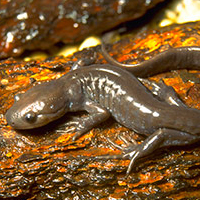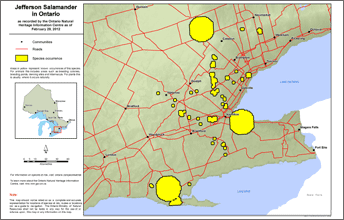Jefferson salamander
Scientific name: Ambystoma jeffersonianum

Cover photo credit: Leo Kenney, Vernal Pool Association
Status
Endangered
“Endangered” means the species lives in the wild in Ontario but is facing imminent extinction or extirpation.
Date added to the Species at Risk in Ontario List
The Jefferson Salamander was assessed as threatened when the Endangered Species Act took effect in 2008. On June 8, 2011 Jefferson Salamander was re-assessed as endangered.
Read the Assessment Report (PDF)
What it looks like
Jefferson salamanders have a grey or brown-coloured back, with lighter under- parts. Blue flecks may be present on the sides and limbs. Adults are 12-20 cm long. The long tail makes up half this length.
Young salamanders (larvae) look like miniature adults, but with external gills. It is difficult to distinguish between Jefferson salamander larvae and that of its close relatives, because adult colouration does not develop until the salamanders leave the breeding ponds.
Where it lives
Adults live in moist, loose soil, under logs or in leaf litter. Your best chance of spotting a Jefferson salamander is in early spring when they travel to woodland ponds to breed. They lay their eggs in clumps attached to underwater vegetation.
By midsummer, the larvae lose their gills and leave the pond and head into the surrounding forest. Once in the forest, Jefferson salamanders spend much of their time underground in rodent burrows, and under rocks and stumps. They feed primarily on insects and worms.
Where it’s been found in Ontario
The Jefferson salamander lives in deciduous forests. Its range extends across parts of the northeastern U.S. In Canada, it is found only in southern Ontario, mainly along the Niagara Escarpment.
View a Larger version of this map (PDF)
What threatens it
This species requires intact deciduous forest with an undisturbed forest floor. These salamanders also need unpolluted breeding ponds that do not dry up in the summer.
Habitat loss and degradation caused by urban development, draining of wetlands and some resource extraction activities are the cause of the decline in salamander numbers in southern Ontario.
Action we are taking
Endangered Species and their habitat are automatically protected
Recovery strategy
A recovery strategy advises the ministry on ways to ensure healthy numbers of the species return to Ontario.
Read the executive summary (May 30, 2018)
Read the recovery strategy (May 30, 2018)
Read the previous recovery strategy (February 18, 2010)
Government response statement
A government response statement outlines the actions the government intends to take or support to help recover the species.
Read the government response statement (February 28, 2019)
Five-Year Review of Progress
A five-year review reports on progress made toward protecting and recovering a species, within five years of publishing a species’ government response statement.
Read the report on progress towards the protection and recovery of 13 species at risk, including Jefferson Salamander (2015)
Habitat protection
A habitat regulation defines a species' habitat and many describe features (e.g., a creek, cliff, or beach), geographic boundaries or other unique characteristics.
Read the regulation (February 18, 2010)
What you can do
Report a sighting
- Report a sighting of an endangered animal or plant to the Natural Heritage Information Centre. Photographs with specific locations or mapping coordinates are always helpful.
Learn more about reporting wildlife.
Volunteer
Volunteer with your local nature club or provincial park to participate in surveys or stewardship work focused on species at risk.
Be a good steward
- Private land owners have a very important role to play in species recovery. If you find a Jefferson Salamander on your land, you may be eligible for stewardship programs that support the protection and recovery of species at risk and their habitats.
- Visit the Ontario Reptile and Amphibian Atlas or Toronto Zoo Adopt-a-Pond website to learn more about amphibians.
Report illegal activity
Report any illegal activity related to plants and wildlife to
Quick facts
- Jefferson salamanders breed in late March or early April. During breeding season, they travel from their overwintering sites to breeding ponds; they generally make this journey on the first warm rainy spring night of the year
- unlike most small animals, Jefferson salamanders can live a very long time; up to 30 years of age
- Jeffersons spend the winter in old rodent burrows or cracks in the rocks below the frost line; they need to find a spot deep in the ground so they don’t freeze over the winter
